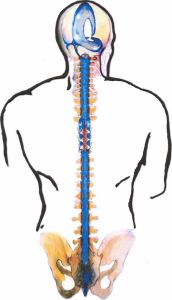
Craniosacral Technique
History
Craniosacral therapy (CST) is a gentle hands-on technique that uses a light touch to examine membranes and movement of the fluids in and around the central nervous system. Relieving tension in the central nervous system promotes a feeling of well-being by eliminating pain and boosting health and immunity.
Craniosacral Therapy is a highly beneficial healing tool when used alone or in conjunction with other therapies. Holistic therapies are by nature hands-on, involving the movement of energy to facilitate healing. CST gives the practitioner the opportunity to incorporate energy movement with physical contact.
Craniosacral Therapy began in the nineteenth century. Originating in Andrew Taylor Still's system of osteopathic medicine, it owes much to subsequent pioneers of technique, such as William G. Sutherland who extended Stills' system into cranial osteopathy. This was refined and codified by Harold Magoun in the 1950's and taught by him to Dr. John E. Upledger in the late 60's.
John E Upledger took on and developed these techniques into what he called 'CranioSacral Therapy', a powerful yet simplified system of treatment capable of being learned by anyone of good intent, wishing to study the system. The unique feature is that it does not require extensive medical training to be effective. Nonetheless, it embodies the essential concepts of Still and Sutherland. CST has evolved in Upledger's lifetime to become a primary holistic therapy aimed at assisting the client to employ their own body's healing capacities.
Craniosacral Technique
Craniosacral therapy is a gentle hands-on treatment that may provide relief from a variety of symptoms including headaches, neck pain and side effects of cancer treatment among many others. CST relieves tension in the central nervous system, promoting a feeling of well-being by eliminating pain and boosting health and immunity.

The focus of CST is a gentle placement of hands to assist in the release of the body's connective tissue, or "fascia." Fascia (Latin word for "band") is a covering found throughout the body including organs, glands, nerves, muscles, blood vessels, brain and spinal cord. This covering forms a body-wide connective network. CST is based on the idea that the body is interrelated at all levels.
CST is thought to relieve compression in the head, neck, and back. This can soothe pain and release both emotional and physical stress and tension. It's also thought to help restore cranial mobility and ease or release restrictions of the head, neck, and nerves.
Who Benefits From Craniosacral Technique
Cranial sacral therapy can be used for people of all ages. It is administered by Holistic Kinesiologist to alleviate conditions like:
- neck pain
- back pain
- migraines and headaches
- constipation
- irritable bowel syndrome (IBS)
- disturbed sleep cycles and insomnia
- scoliosis
- sinus infections
- fibromya lgia
- recurrent ear infections or colic in infants
- TMJ
- trauma recovery, including trauma from whiplash
- mood disorders like anxiety or depression
- difficult pregnancies
- brain and head injuries
- brain fog and dementia
- neurological challenges
- ADD/ADHD
Procedure And Technique
When a client arrive for an appointment the Holistic Kinesiologist will ask the client about any symptoms and/or any preexisting conditions they may have. During the healing session, some clients may experience different sensations. These may include:
- feeling deep relaxation
- falling asleep, and later recalling memories or seeing colors
- sensing pulsations
- having a "pins and needles" (numbing) sensation
- having a hot or cold sensation
Cranial Sacral Therapy
Gentle Touch | Non-Invasive | Energy | Synchronicity
Central / Peripheral / Parasympathetic Systems Influences entire body Moves CSF/Blood/Lymph

This therapy is not intended to overtake the body's innate cranial sacral rhythm. It works to enhance and encourage the motion and movement of tissues, bones and fluids.
